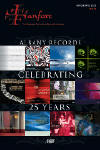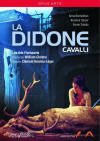Texte paru dans: / Appeared in:

Fanfare Magazine: 36:4 (03-04/2013)
Pour
s'abonner / Subscription information
Les abonnés à Fanfare Magazine ont accès aux archives du
magazine sur internet.
Subscribers to Fanfare Magazine have access to the archives of the magazine
on the net.
Opus Arte
OA1080D

0809478010807 (ID248)
Francesco Cavalli’s La Didone (1641) is one of the earliest relics of operatic history. To put it in perspective, the opera was written more than 50 years before any of America’s founding fathers were born and more than 100 years before the birth of Mozart. The venerable Venetian manuscript, now nearly 400 years in age is of historical interest for another reason as well, it was the first commissioned work for public performance in Venice. Opera until that time had been confined almost exclusively to princely palaces and aristocratic drawing rooms. The play for pay innovation was to herald some other fundamental changes in opera as well, the catering to popular tastes, the advent of wondrous theatrical special effects, the full development of the aria form, and the rise of virtuosic singing along with the virtuoso singers themselves, the castrati and the prima donnas. But all of that was in the future when Cavalli’s work hit the stage in Venice. One immediate impact however was that La Didone had to be composed for smaller, more affordable instrumental forces (one could as yet hardly call them orchestras) than the more splendid groups of instrumentalists afforded by royal courts and wealthy aristocrats. Here the work is scored for basso continuo and just a few string instruments.
The drama itself is excellently crafted by librettist Giovanni Francesco Busenello, also the librettist for Monteverdi’s ground-breaking opera L’Incoronazione do Poppea. Taken from Virgil’s Aeneid, the work is taut and harrowing in act I with the depiction of the immediate aftermath of the fall of Troy and the horrors of warfare. The second part of the opera blossoms into the love story of Dido, Queen of Carthage, and Aeneas, noble Trojan warrior and survivor of the destruction of his homeland. But Virgil’s ultimate destiny for Aeneas is to go on to Italy and found the city of Rome on the fabled seven hills so as to provide the Romans with just as noble a mythic heritage as the culturally superior Greeks. Anyone who looks at a map may wonder how experienced sailors could set out from Troy, now northwestern Turkey, aiming for Italy and end up in North Africa, even in ancient times it would seem to be quite a serious error in navigation, but then it’s Virgil’s story. The love story becomes a tragedy when Aeneas is compelled by the gods to leave Carthage, and the rejected Dido commits suicide. Only here, the unhappy queen is saved from herself by Iarbas, King of the Getuli, who also loves her and the two of them find happiness with each other.
It may be a bit presumptuous to critique a neatly 400 year old libretto, but the two parts of La Didone look to all appearances like two different stories. Of course, the same could be said of Berlioz’s more famous Les Troyens, which covers similar ground. Characters come and go in the act I setting in Troy, all with singing bits, but very few of them show up in act II Carthage, only Aeneas, his stout-hearted men (and errant sailors), the goddess Venus, who packed a valise, Aeneas’s father (who didn’t make it to Carthage in the Aeneid), and his young son. A different mix of characters populates acts II and III when the love story is given. In fact, there are so many characters the cast has to double and triple up to cover all the roles. The music of La Didone is fairly rudimentary early Baroque, consisting mainly of sung recitatives accompanied by basso continuo, still a quite recent novelty in 1641, especially for the non-aristocratic public who were hearing it for the first time. At certain places the music opens out into arioso passages where the extra instruments join in, set to madrigal-like couplets. Full-blown arias are nowhere yet to be seen. At times some rather ribald humor is inserted, including a sung bit reflecting on Greek king Menelaus’s “horns” as his wife Helen lies in another man’s arms, and the act II dalliance of King Iarbas with three alluring court ladies.
This production from Caen is quite well done. Sets are kept to two, one for each location (Troy and Carthage) and are quite evocative of their milieus. Costumes are vaguely ancient and colorful, the gods and goddesses dressed in similar fashion to the mortals. In act II the gods’ domain is a rather tacky looking modern scaffolding tower they can romp up and down. In act I, in the detritus of fallen Troy we see the carcass of a dead stag. Then in act III Aeneas’s men drag into the palace, what else, the carcass of a dead stag. (You don’t suppose they brought it with them?) This allows Dido to dreck up in fresh blood as she is contemplating suicide, like an ancient Lucia di Lammermoor. Not a very original touch, but the artistic interventions here and there don’t really intrude on the central drama or dramas. The musical side could hardly be better, led by early-music specialists Anna Bonitatibus and Kresimir Spicer as Didone (Dido) and Enea (Aeneas). Several members of the young cast are affiliated with William Christie’s teaching workshops in Caen and are well schooled in the techniques of the early Baroque. Cavalli’s score doesn’t really challenge the voices much and everyone sings very well, although a couple of the melodic bits are imbued with a bit more emotive force than the situation requires. Christie himself accompanies from the harpsichord (basso continuo) and his ensemble Les Arts Florissants performs meticulously.
Quite unbelievably, there is actually a competing video set of La Didone on the Dynamic label (though not in Blu-ray format), although it follows a later 1651 manuscript from Naples. I have not seen it, nor do I know if there are significant textual or musical changes, but Barry Brenesal reports favorably on the audio portion of it available on CD in Fanfare 35:1. Despite the minor drawbacks I have managed to dredge up here this is a fascinating opera in some of the sharpest video quality I have yet seen, and with good HD sound. If you are at all interested in the roots of opera or even if you just like a pretty compelling story, this classy set is self-recommending.
Cliquez l'un ou l'autre
bouton pour découvrir bien d'autres critiques de CD
Click either button for many other reviews


